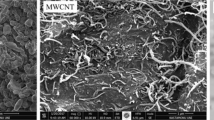Abstract
The goal of the present work is the refinement of the pore morphology of aluminum integral foam castings. Integral foam molding, a modified high pressure die casting process, is used where a mixture of melt and blowing agent particles (magnesium hydride, MgH2) is injected at high velocity into a permanent steel mold. At the mold surface, decomposition of the blowing agent and pore formation is suppressed due to the high solidification rate whereas solidification of the core is much slower allowing blowing agent decomposition, pore nucleation, and growth. Blowing agent particles not only act as gas suppliers but also represent pore nuclei. Thus, microcellular foam cores can be attained by increasing the number of MgH2 particles. But increasing the number of powder particles by powder milling strongly decreases the flowability and strong particle agglomeration as a result of the increasing cohesive forces leads to inhomogeneous foams. Flowability of the powder can be restored by coating it with SiO2-nano-particles resulting in a homogeneous microcellular foam morphology.








Similar content being viewed by others
References
Körner C, Singer RF (2000) Adv Eng Mater 2:159
Nosko M, Simančik F, Florek R (2010) Mater Sci Eng, A 527:5900
Bin J, Zejun W, Naiqin Z (2007) Scr Mater 56:169
Andrews EW, Gioux G, Onck P, Gibson LJ (2001) Int J Mech Sci 43:701
Wen CE, Yamada Y, Shimojima K, Chino Y, Hosokawa H, Mabuchi M (2004) Mater Lett 58:357
García-Moreno F, Mukherjee M, Solórzano E, Banhart J (2010) Int J Mater Res 101:1134
Körner C, Hirschmann M, Bräutigam V, Singer RF (2004) Adv Eng Mater 6:385
Körner C (2008) Integral foam molding of light metals: technology, foam physics and foam simulation. Springer-Verlag, Berlin, Heidelberg
Hartmann J, Trepper A, Körner C (2011) Adv Eng Mater 13:1050
Linsenbühler M, Wirth K-E (2005) Powder Technol 158:3
Campbell C, Keaveny B (2011) In: Houson I (ed) Process understanding: for scale-up and manufacture of active ingredients. Wiley-VCH, Weinheim
Körner C, Arnold M, Singer RF (2005) Mater Sci Eng, A 396:28
Stanzick H, Wichmann M, Weise J, Helfen L, Baumbach T, Banhart J (2002) Adv Eng Mater 4:814
Acknowledgements
The authors acknowledge the financial support of the Deutsche Forschungsgemeinschaft (DFG), Grant No. KO 1984/5-2.
Author information
Authors and Affiliations
Corresponding author
Rights and permissions
About this article
Cite this article
Hartmann, J., Blümel, C., Ernst, S. et al. Aluminum integral foam castings with microcellular cores by nano-functionalization. J Mater Sci 49, 79–87 (2014). https://doi.org/10.1007/s10853-013-7668-z
Received:
Accepted:
Published:
Issue Date:
DOI: https://doi.org/10.1007/s10853-013-7668-z




